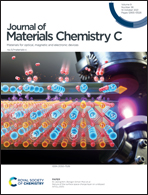The enhanced performance of a Si–As–Se ovonic threshold switching selector†
Abstract
The use of three-dimensionally interleaved memory for enormous data mounts with reduced energy consumption is a future technology frontier. Two-terminal ovonic threshold switching devices are a promising form of selector technology favored by industry, and their excellent electrical properties make them an indispensable component for the realization of large-scale crossbar arrays. However, their relatively low thermal stability and difficulties relating to threshold voltage modulation are two huge obstacles preventing their application. In this paper, via doping Si into AsSe, the regulation of threshold voltage (Vth) and a lower Ioff value (∼10 nA) are achieved. Vth increases with Si doping. A fast operation speed of about 10 ns is also achieved for both turn-on and turn-off. Also, satisfactory endurance of larger than 107 cycles is attained. Compared to AsSe, Si–AsSe OTS materials show better thermal stability without crystallization after annealing at 450 °C for half an hour, which results from the more stable amorphous network made of newly formed Si–As and Si–Se bonds and the inhibition of atom drift. The increase in Vth is attributed not only to a depletion in the number of defects but also to electron orbital aspects, as silicon-induced orbitals lie at deeper energy, making electron hopping to the conduction band harder. Our research provides insight into the relationship between the material microstructure and the device performance during OTS, paving the way for further OTS material screening.



 Please wait while we load your content...
Please wait while we load your content...